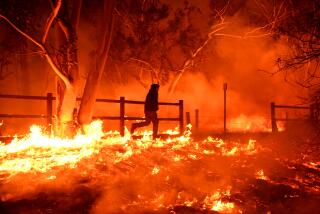Power lines blamed in ’07 Malibu fire
In the gusty predawn hours of Oct. 21, 2007, portions of three wooden utility poles in Malibu Canyon snapped and fell to the ground. Sparks from live electrical wires ignited dry brush, creating an inferno that raced down the canyon into the Civic Center area, destroying 14 structures and 36 vehicles.
A California Public Utilities Commission investigation concluded that the poles were so overloaded with electrical and telecommunications wires and other equipment that they broke in winds they should have been able to withstand.
In another report, the commission found that sparks from power lines downed by strong winds were blamed for three of four brush fires that burned through 200,000 acres in San Diego County and destroyed more than 1,300 homes that same year.
With downed power lines blamed for several of the biggest fires to hit Southern California in recent years, including last year’s Sesnon fire in the San Fernando Valley, officials are being pressured to deal with the risk.
Southern California Edison, telecommunications firms, cable providers and other regulated utilities have been meeting with the commission and fire agencies to review potential changes in state standards for utility poles in high-risk areas.
Some utilities are acting before any new rules and regulations are devised.
San Diego Gas & Electric has floated a plan to turn off power to some of its 60,000 back-country customers when Santa Ana winds threaten to knock down power lines. The proposal would allow the utility to turn off power when winds hit 35 mph.
The plan faces strong opposition from a coalition of consumer groups, schools, water and fire districts and telecommunications companies. Last week, that coalition asked the utilities commission to reject the company’s “pro-active de-energization” plan. An administrative law judge is expected to issue a proposed ruling by July, with the full commission taking up the matter before the fall fire season.
In the Malibu case, an administrative law judge has scheduled a conference for May 13 in San Francisco as prelude to a hearing aimed at determining whether Southern California Edison and telecommunications companies that shared the utility poles had violated rules on the amount of equipment they could safely install. The commission named Edison, Verizon Wireless, Sprint Communications, NextG Networks of California and AT&T; California and AT&T; Mobility as joint owners.
Verizon Wireless said in a statement that “while we believe the weight and composition of our fiber optic cable could not have contributed to the Malibu fire, we are investigating and cooperating fully with the commission.”
Malibu Mayor Andy Stern said the report highlights a serious problem. No one, he said, appears to be taking ultimate responsibility to ensure that power poles do not become overloaded.
“There should be an investigation, with a log for each additional utility showing they’ve done a weight-load check,” Stern said. “There’s a huge problem and no one is addressing it. I think these [poles] are ticking time bombs.”
Putting utility lines underground has been suggested as a possible solution, but Stern said that “would take forever and be prohibitive.”
Although power utilities such as Edison and San Diego Gas & Electric typically install poles, they share ownership with companies providing other services. The Southern California Joint Pole Committee, founded in 1906, keeps track of the ownership stakes.
Edison spokesman Steven Conroy said the utility “takes serious responsibility for maintaining our poles and wires.” Each time another company adds wires or equipment, he said, it is that company’s responsibility to calculate whether the pole can safely handle the load.
“If we hang something different or add another piece of equipment, we are obligated to do calculations or follow whatever rules are necessary for adding weight,” he said. “Are we responsible for others [who add equipment]? The rules say we are not.”
He said the utility could not comment further because of pending lawsuits filed by Malibu homeowners.
San Diego Gas & Electric, meanwhile, has taken other steps to decrease the chances of another firestorm like those in 2007. It has increased tree trimming near power lines and replaced some wooden poles with metal ones while stepping up maintenance of lines and poles.
Turning off power is “our last line of defense,” said David Geier, vice president of electrical transmission and distribution.
A study by the company suggested that the strategy would probably be used only once or twice a year, affecting 8,000 to 10,000 people.
Opponents accused the utility of ignoring the potential problems of looting in areas without power and noted that schools without power could not be used as sanctuaries for families fleeing a blaze.
More than 125 homeowners have sued San Diego Gas & Electric for damages from the 2007 fires. In an earnings statement Tuesday from its parent company, Sempra, the company said it was negotiating with insurance companies and had set aside $900 million for possible settlements, a figure that would be covered by insurance.
Southern California Edison said it, too, has insurance that would cover legal settlements.
--
tony.perry@latimes.com
More to Read
Start your day right
Sign up for Essential California for news, features and recommendations from the L.A. Times and beyond in your inbox six days a week.
You may occasionally receive promotional content from the Los Angeles Times.







